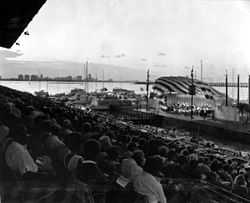Miami Marine Stadium
| Miami Marine Stadium | |
|---|---|
 Concert-goers watch an evening concert on Biscayne Bay, 1967 | |
| Former names | Ralph Munroe Marine Stadium |
| Location | Virginia Key, Miami, Florida, United States |
| Coordinates | 25°44′35″N 80°10′12″W / 25.74295°N 80.169865°WCoordinates: 25°44′35″N 80°10′12″W / 25.74295°N 80.169865°W |
| Opened | December 27, 1963 |
| Expanded | 2011–present[1] |
| Closed | September 18, 1992 |
| Owner | City of Miami |
| Surface | Marine |
| Construction cost | $2,000,000 (1963)[2] |
| Architect | Hilario Candela |
| Capacity | 6,566 |
| Acreage | 240 acres (970,000 m2) (land and water) |
The Miami Marine Stadium is a marine stadium on Virginia Key, Miami, Florida, United States. The facility, built and completed in 1963 on land donated to the City of Miami from the Matheson family, is the first stadium purpose-built for powerboat racing in the United States.
Background
History
The 6,566 seat stadium was built in 1963 on land donated for "water sports," and designed by architect Hilario Candela, then-a 28-year-old recent immigrant from Cuba. It was dedicated as the Ralph Munroe Marine Stadium opened, completed at a cost of around $2 million ($15.3 million, adjusted for current inflation). A speed boat racer, James Tapp, was killed on opening day. The venue, located just south of Downtown Miami, was revered for its scenic views of Downtown and Miami Beach, hosting motorboat events, and events featuring the likes of Mitch Miller, Sammy Davis, Jr., and U.S. President Richard Nixon (whose seasonal winter residence, dubbed "the Florida White House," was on nearby Key Biscayne).
In 1979, Miami Rowing Club relocated to an empty lot between the stadium and MAST Academy (then known as Planet Ocean museum. The MIAMI INTERNATIONAL REGATTA has been hosted by Miami Rowing Club since 1973, the basin provides a 1,500 meter 7 lane course for practice, training and racing.
From its opening for nearly 30 years, the stadium was used for its intended "water sports" as well as concerts, sporting events such as boxing, which began in 1972. In the wake of Hurricane Andrew, it was declared an unsafe building under Miami-Dade County building code on September 18, 1992. In 2004, $3,000,000 was pledged in a municipal bonds by county residents for the restoration and renovation of the facilities.
Facilities
The Stadium was host for many world class powerboat events including Unlimited Hydroplane, Inboard, Outboard, Performance Craft, Stock, Modified, Grand National divisions as well as other special event races. The Stadium was also the site of a number of nationally televised events including the Bill Muncey Invitational and the ESPN All American Challenge Series. The last major race in the Stadium was the 1987 Inboard Hydroplane national Championship.
Since its condemnation in 1992, the stadium has become a haven for graffiti artists, but remains an attraction for its photographic panoramic view of the central business districts and barrier islands of Miami.
On April 28, 2009 the National Trust for Historic Preservation named the Commodore Ralph Middleton Munroe Marine Stadium to its list of America's 11 Most Endangered Historic Places.[3] On April 18, 2012, the American Institute of Architects's Florida Chapter placed the stadium on its list of Florida Architecture: 100 Years. 100 Places as the Ralph Middleton Munroe Miami Marine Stadium.[4]
References
- Notes
- ↑ "A Magic Tour of Miami Goes From Art to Zoo". The Miami News. 9 February 1968. Retrieved 11 August 2011.
- ↑ Rabin, Charles (25 July 2011). "Miami Marine Stadium rehab on hold in dispute between city, preservationists". The Miami Herald. Retrieved 11 August 2011.
- ↑ National Trust 2009
- ↑ Florida Architecture: 100 Years. 100 Places
- Bibliography
- National Trust for Historic Preservation 2009
- Preservation Magazine - An Architect and His Stadium
- Critical Miami - Photo of the Stadium from January 2007
- Civil Engineering Database - Evaluation of Cracking of the Miami Marine Stadium Hyperbolic Paraboloid Roof Structure
- Hibblen Radio - 31 photos taken throughout the structure in August 2006 showing extensive vandalism and cracking
- National Trust for Historic Preservation - America's 11 Most Endangered Historic Places
- Professional boxing record for Randy Clark from BoxRec
- Professional boxing record for Frankie Otero from BoxRec